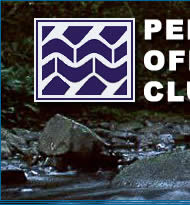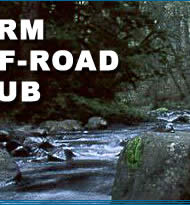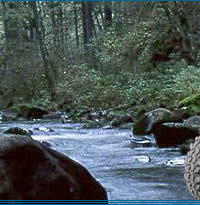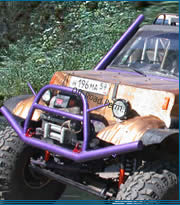|
A Summer Trip To the Chuvalskiy Stone.
Related by Konstantin Zykov.
In July 2005, having prepared my UAZ for off-road trips, my family
and I decided to go in for an expedition to conservation area
in the North of Perm Region. The route was mapped out according
to the following points:
" It must be a place which we even did not dream to reach.
" On the route to the place there must be neither vehicle
no people besides us.
" The place must be magnificent.
Taking into account the above-mentioned points we chose the following
route Perm - Berezniki, Krasnovishersk, Vaya, Vels, then onto
the Chuvalskiy Stone and the Mountain Zyryanovka, along the river
Big Moyva to the Bikhtiyarov Chum (a kind of hut), then along
the river Vels source and along the ridge Molebnyi Stone to Sverdlovsk
Region and at the end we planned to go back to Perm along the
common road.
We also worked out a spare route to be on the safe side - behind
the mountain Chuvalskiy Stone and Zyryanovka, along the river
Vels there is a turn to the abandoned Siberia Priisk (field) and
a way out to Sverdlovsk region onto the common roads.
Running a few steps forward I must confess that our trip turned
out to be neither first nor second but third… but all in good
time.
So on 21 June early in the morning my whole family - my wife Olya,
our son Oleg, our daughter Lena, me and our dog Tuzik left Perm
for the expedition. Having passed Berezniki we drove toward Krasnovishersk
and then to the village Vaya. We went on the asphalt road enjoying
the passing forest. In Krasnovishersk we filled the tanks and
gasoline cans with fuel because further on there were no petrol
stations. That night we reached the village Vaya and got across
the river Vishera to the other bank by the cable ferry.
In the village we found something looking like a petrol station
though with no man in charge. The local people told us that he
would come the next morning . So we decided to camp in the nearby
forest. It was already pitch-dark and raining hard into the bargain
when we erected a tent. We had a quick dinner and went to bed.
In the morning on 22 July we slept long as we had got quite exhausted
the day before. After a slow and pleasant breakfast we dismantled
the tent and went to the village filling station. Alas! There
was again no man in charge. And again the local people told us
that he had gone to mow grass. What should we do? We needed petrol
badly. Happily we found a local village old man who had a lot
of fuel in store, he sold us 20 liters. Now we had our tanks full
and could continue our trip in the direction of the village Vels.
In Vels we had to wade the Vishera. It was our first serious off-road
adventure.
At first we searched the bank for the shallow areas driving here
and there because they could be not found visually. As a result
of such searching I explored approximately a kilometer of the
Vishera bed. Having chosen the most shallow and the least rocky
bottom so that the car should not drown I made up my mind to cross
the river lower than the village down-stream. Although the water
was 1m 30cm a very strong river current made the process of crossing
a lot more complicated.
The fear of the thing that the car could rise in the stream and
drift away made me think of unwinding the rope of the winch and
fastening it to a tree on the opposite bank. It turned out to
be more difficult than I had supposed. The matter was that I could
cross the river without the rope but when I held it in my hands
the mission was absolutely impossible because when the rope got
into water it immediately began to drift away with the current
and I consequently drifted too. I tried 10 times but failed! I
got exhausted and made up my mind to think the problem over. Finally
I came to the following conclusion. All I had to do was to pull
the rope up-stream to the maximum and then run, swim, rush to
the opposite bank. The plan was a success. I got on the other
bank just in front of my car and fastened the rope on the tree.
Now the crossing was a question of technique. The village people
in Vels were shocked when they saw us driving along their streets
because the only vehicle they had ever had there was huge trucks
(Urals). On these trucks they go into the fields for mowing grass
just along the bed of the river Vels (I saw it myself).
When we left the village we stopped to have a snack, to take pictures
of beautiful rocks, to map out the route.
As we did not find the road along the Vishera which was marked
in our atlas we chose an alternative track - at first we went
along the Vels bed then through the forest in the direction of
the Vishera not far from ruins of the village Priiskovaya. The
track was rather hard, we often rode through bushes and young
trees clearing the way with a petrol saw.
Fallen needles of young fir-trees growing right on the way, last
year's leaves and grass got into the radiator and stopped it up.
As the car overheated we had to stop to pour the water on the
radiator and shake the rubbish off. I did it with a branch but
I twice did it with a hand hack-saw. As a result there appeared
holes in the radiator. So it taught me a good lesson - never touch
the radiator with metal things! I had nothing to do but use the
so-called cold welding. Thank goodness it helped and the radiator
stopped leaking!
On the way we had to cope with a lot of difficulties such as bogs,
deep pits with running streams at their bottoms and wading the
Vishera tributaries. We used the winch all the time - while getting
out of the fords on the bogs and in pits of course. Actually after
several trips on rugged territories I arrived at a conclusion
that a winch is the main valuable off-road accessory. You can
put in your landrover nothing but a winch is a must that should
be taken with you. In need it will come to your help undoubtedly.
Well, it was getting dark and we began to seek a place to spend
the night. As there were no clearings in the forest at all we
had nothing to do but camp on a stony reach of the river near
the littoral grass.
From that place we could see the Chuvalskiy Stone - the mountain
912 meters high above sea level. We put up a tent, made the bed
for our children in the car, made a fire and went to bed. It was
the second day of our trip.
It was just getting light when the awakening nature let us know
about itself. Unluckily two 'paradise' birds somewhere near began
singing in a very bad voice to put it mildly and that disturbed
our sleeping a great deal. Having had breakfast we started the
way. For some time we moved along the river and then the track
turned right in the direction of the Chuvalskiy Stone. We sawed
the trees which had fallen down on the ground and blocked our
way.
Going farther into the forest we arrived at a big clearing. We
were much surprised to see the track cleared so that a KAMAZ could
easily go there. The way was the same up to a mountain stream
which we crossed and reached a forester house. As usual there
was a kind of bed for sleeping, tea, sugar, salt, firewood and
the stove. Outside it there were traces of a fire - some people
had been there.
Later the track went up the hill. The slope was not less than
30 degrees, the car moved hard on low gear. In a few minutes the
trees disappeared and we saw bushes, a little later the bushes
disappeared as well and we saw moss and flattened bushes half
a meter high. Such great changes in the mountain greenery always
amaze! The same could be said about the temperature which was
+31-33 degrees at the foot and +23-25 degrees on top of the Chuvalskiy
Stone.
What really pleased us was the absence of gadflies, horse-flies
and mosquitoes and a nice fresh wind. We also appreciated stony
embankment apparently surviving since prehistoric times. On top
of the rocky embankment we took notice of a metal tablet. It is
a pity that the text was not readable that was why we just took
a picture of it and left.
About 20 minutes later we achieved the climax of our expedition
- top of the mountain the Chuvalskiy Stone or the Chuval as they
might call it. In front of our eyes appeared a grand picture -
the plain plateau stretching far away for not less than 10 hectares
at a height of more than 900 meters above sea level.
In the middle of the plain, like a podium for the winner who conquered
the hill there is a flat rock 7x5 meters, rising very little above
the whole surface. One can see there a tremendous sublime panorama
- the sights of the neighbouring mountain tops which are several
tens of kilometers away from us. At the foot of the Chuval in
the forests there is the Vishera river bed. At a very far distance
somewhere above Cherdyn it is pouring and the sunset paints all
this splendour into purple and crimson colours.
We were just standing on the mount and watching this world from
above - it is impossible to put into words the childish delight
which we were filled with at that majestic moment. So we glanced
around for an hour and a half till it became dark. We found a
glade of moss where we pitched the tent. Having warmed food on
the gas-jet and having had a light supper we went to bed.
As the day was full of strong emotions and impressions I could
not sleep. So I spent the night admiring the Moon above the hills.
The Moon being full was hanging above the ridge Martay like a
red disc. Even the Earth sputnik was different in the mountains.
Maybe at that very moment I became absolutely sure of the fact
that the Urals would never let us go and we would have to come
to them in the future. Finally I got calm and relaxed and fell
asleep.
When morning came we had breakfast and went to have a look at
the rocks which were a bit lower than the top.
Climbing rocks and stones is exciting though fairly tiring.
I think our dog Tuzik was especially pleased with fresh air, picturesque
surroundings and a lot of area to mark. What else does a dog need
to be completely happy?!
Having examined the territory with binoculars we found a tourist
lodge which was located not far from the turn to the Chuval (it
is about 7 km up the Vishera stream). We could see tents and a
Kamaz which had obviously brought a group of tourists.
After packing our belongings we were ready to leave.
BUT! ATTENTION! I turned on the GPS navigator to find the way
to the Bikhtiyarov Chum (hut) and uninhabited settlement Sibirevskiy
Priisk. But There Was No Road! As I understood later the track
was close but not on the slope (where I sought trusting the map
in the GPS) but on top of the mountain.
The shift in orienteering was only 300-350 meters but it turned
to be enough for me to fail to find it. I explored the virgin
forest coming upon big rocks and beds of wild animals. I could
not understand why I could not find the track. Now I realize that
I should have taken the atlas, should have found the road in it
and should have carefully examined it.
Of course I did it but it happened later, in a few days, at home.
But that day in the mountains I was quite at a loss. To make the
things worse it started pouring and having resolved that I had
no right to risk my family we turned back. As far as Olya and
children were concerned they were even glad because they are less
romantic travelers than me.
After we descended from the mountain on the same road we resolved
to call in on the way on the tourist lodge which we had seen from
the top. Since there was no path leading there we continued our
way right in the Vishera. I all the time examined the water walking
in it only then we drove in the car. Accordingly we crossed the
river 5 or 6 times choosing the most shallow places. Once the
current was especially strong, the vehicle refused to go across
it and began skidding. I had nothing to do but resort to the help
of the winch. In such a way we passed the most difficult area.
Breaking through inch by inch we covered about 4 km of water and
stopped on an island for a rest. We made a fire and my wife Olya
cooked a marvelous soup for us all - a real feast. Each of us
ate a huge plate (not less than 600g).
At that time beside the island a group of raftsmen was rafting.
A great surprise was written on their faces when they saw on the
island people (that is us) and the car! The instructors rafting
behind the group landed and came up to us with a question how
we had arrived there. When we told them that we had come from
the top of the Chuvalskiy Stone and showed the photos in the notebook
their amazement and delight knew no bounds. After a short talk
and a glass of "gorilka" (very strong vodka) they left.
As for us we also drove out. And now we chose a new tactics: Oleg
had to sit on the hood and look into the water for pits and this
was our mistake. Oleg saw the pit but it was too late - we had
already got into it. The water inside the car rose very quickly.
The engine did not fail but the car refused to move back: all
four wheels skidded. I had again to unwind the winch rope and
fasten it on the opposite bank. At last we managed to get out
of that trap. Checking the level of the technical liquids I found
out a problem: we had got so deep that water penetrated into the
engine and now instead of oil there was a mixture of oil and water.
Since we did not have so much spare oil we determined to go on
this emulsion on small revolutions. Happily the things took a
turn for the better. In 8 hours of driving water evaporated and
the oil became pure again. Here is RUSSIAN UAZ! Can go on a mixture
of oil and water.
In a few minutes we arrived at the tourist lodge confusing fishermen
and tourists. The rest of the day we drove till I became sleepy.
We did not pitch a tent, slept sitting next to the village Mutikha;
the following day was the same, we drove throughout the day and
in the evening came back home.
This was the end of our trip to the Urals, which was only the
beginning of exploration of paths and secret places of the Urals.
Leaving we did not say 'Good-bye', we said 'See you……….'
The track* of the trip in format OziExplorer>>
*Comment of Konstantin Zykov.
The track was paved from an uncertain place on a common road.
The route was handmade, from memory, in accordance with the map
in OziExplorer and does not display the exact trajectory of our
trip.
Written by Mikhail Shardin.
|







